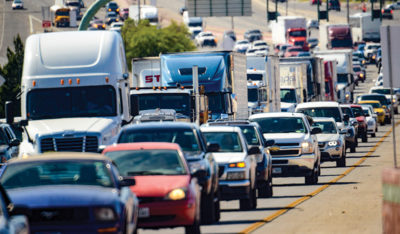 Traffic congestion receded in spring 2020, then bounced back in fall
Traffic congestion receded in spring 2020, then bounced back in fall
Roadway bottlenecks were back to near pre-pandemic levels in Texas in late 2020 after overall hours wasted in traffic dropped by more than half in the early part of that year, according to a new traffic study performed by the Texas A&M Transportation Institute (TTI).
The study of the state’s most congested street and highway segments, conducted annually by TTI, noted very little movement in rankings. However, the overall delay on these roads was sharply reduced by a pandemic-driven drop in traffic volume and a temporary shift of traffic concentration away from peak “rush hour” periods.
These factors were first illustrated in July by the 2021 Urban Mobility Report (UMR), also managed by TTI.
Funding for both the state and national studies was provided by the Texas Department of Transportation (TxDOT).
Drivers experienced lower traffic delays on the monitored Texas roadways in 2020 than they did in 2019. More delays also occurred outside typical rush hours than in the previous year, likely due to the increased number of people working from home and school closures.
Delay for trucks was also down, especially during the early days of the shutdown, though truck volumes and associated delay recovered at a faster rate than passenger vehicles. This is perhaps an indicator of how home and store deliveries were sustained – and in many cases increased – throughout the pandemic. “Traffic delay reductions across the board were far greater than anything we’ve seen before,” says David Schrank, a senior research scientist at TTI who directed the analysis. “Barring another unforeseen crisis, we are very unlikely to see such rare conditions ever again.”
Houston’s West Loop / IH 610 was the most congested road segment in the state in 2020, trading places with IH 35 in Austin, which held the top ranking in 2019. That same Austin road section was the most gridlocked for trucks in 2020, just as it was the year before.
The sharp drop in delay time on Texas roadways was short-lived, with traffic volume steadily increasing in the fall of 2020, as it did generally throughout the U.S. during the same time. Population growth in Texas continues to outpace national trends, prompting the Texas Transportation Commission to launch Texas Clear Lanes in 2015, an effort designed to relieve congestion in the state’s major urban areas.
“While 2020 was a very unusual year for traffic patterns, it’s important to note that congestion jumped back quickly to almost pre-pandemic levels as we have moved through 2021,” says Brian Barth, TxDOT Deputy Executive Director for Program Delivery. “And even with an unprecedented set of circumstances for the early part of 2020 – to include a complete state shutdown – drivers still experienced some delays. With more people coming to Texas every day, especially in our metro areas, it remains imperative to improve mobility through efforts such as Texas Clear Lanes.”
Congestion relief efforts are designed to improve conditions not only for travelers, but also for the increasing amount of truck freight activity. Researchers say the importance of that activity is underscored by the supply chain disruptions experienced during the nation’s worst public health crisis in a century.
“Perhaps no year in our memory has seen more attention brought to trucking, transportation logistics, and the global supply chain than the pandemic year of 2020,” says Bill Eisele, a TTI senior research engineer. “The results of this year’s study of congested roads in Texas reflect this increased demand, as many of the worst freight bottlenecks are new to the top 100, including some along the U.S.-Mexico border where trucking was especially active to keep up with supply demands.”
In addition to much-needed construction projects that increase roadway capacity, researchers note other factors that can help reduce congestion.
“The work-from-home and school-from-home aspects of our COVID-19 experience clearly show just how much delay reduction we can obtain if we change how we work, shop, and educate,” Schrank says. “Maintaining the level of the 2020 delay reductions using telework, more travel options and better information for travelers when they’re not forced upon us by a pandemic, however, could be more difficult, as more traffic is returning to roads and population growth continues.”
Schrank points to a study last year by the U.S. Bureau of Labor Statistics, which estimated that 63 percent of American jobs require significant onsite presence, while the remaining 37 percent can be performed entirely from home.
“The rankings for 2020 reflect some of the traffic anomalies that resulted from COVID-19,” he says. “There is still much remaining for us to understand about how these impacts might be sustained, as traffic volumes have now returned to pre-pandemic levels in many urban areas.”